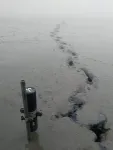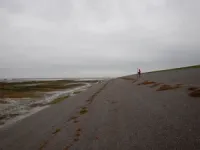(Press-News.org) Salt marshes provide multiple ecosystem services, one of those is protection of the coast against flooding. This is especially important in low-lying countries like the Netherlands. Scientists from the University of Groningen and the Royal Netherlands Institute for Sea Research (NIOZ), in collaboration with the local water authority, have monitored wave run-up during storms over a three-year period. The results, which were published in the Journal of Applied Ecology on 10 May, help the water authority to quantify the protective effect of salt marshes.
For three years, ecologist Beatriz Marin-Diaz always had one eye on the weather forecast during the storm season. ‘After a storm we had to visit our research area to assess the impact of the waves,’ she explains. The research area was situated along the Wadden Sea, a shallow zone between a range of barrier islands and the northern coast of the Netherlands consisting of tidal flats and wetlands. ‘Most of our knowledge about the protection these marshes provide is from models. However, little data is available on what is really happening in the open air.’
Observations
Along the coastline, Marin-Diaz has taken different measurements, such as elevation of the mud flats, the width of salt marshes, and the vegetation growing there. The impact of storms was assessed using wave loggers, but also by measuring the position of flood marks on the dikes. Next to the measurements she took herself, Marin-Diaz also received data on wind direction and strength from the Royal Dutch Meteorological Institute (KNMI). Moreover, she analysed charts dating back some twenty years to study changes in the size of salt marshes. The paper in the Journal of Applied Ecology is based on the observations and measurements during three storm seasons.
The results show that salt marshes indeed reduce the wave run-up on dikes. ‘The key message is that compared to bare tidal flats, marshes were more effective in reducing run-up on the dikes,’ explains Marin-Diaz. ‘This finding is not dependent on the wind direction of the storm, the exposure relative to the barrier islands, the grazing state of the marsh, or the vegetation type.’ The main drivers appeared to be the foreshore elevation and marsh width: higher foreshores and wider marshes provide more protection.
Moderating influence
Furthermore, Marin-Diaz observed that in areas where the mud flat elevation is relatively low, salt marshes are absent. Her long-term analysis showed that marshes expanded in areas where the adjacent tidal flats where higher (more than 0.5m above the average local sea level), while salt marshes retreated mainly where the mudflats in front of them were affected by erosion. ‘The areas where marshes are not developing are in turn the ones that would need more protection. Our conclusion is therefore that in some locations, we will still depend on hard engineering solutions because these nature-based defences are not effective enough.’
This is an important conclusion for the local water authority. ‘The study provides data that allow us to estimate the reduction of wave height and run-up depending on the presence and characteristics of the salt marshes in front,’ comment Kornelis de Jong and Jan-Willem Nieuwenhuis, two co-authors from the water authority. ‘We can now distinguish between protective requirements of dike stretches with and without salt marshes. This will have a moderating influence on future reinforcement works and their costs along these stretches.’
Wading birds
In areas where marshes do not naturally occur, human interventions can help with their establishment. Marin-Diaz: ‘Building sedimentation fields or adding sediment to stimulate the growth of new salt marshes could be one solution, although creating new marshes may have drawbacks as well. It would be at the expense of tidal flats, which are important to wading birds. Furthermore, in some locations, marshes are simply not able to grow, even with human interventions. In that case, strengthening the dikes may be required.’
Reference: Marin-Diaz, B., van der Wal, D., Kaptein, L., Martinez-Garcia, P., Lashley, C., de Jong, K., Nieuwenhuis, J.-W., Govers, L.L., Olff, H. and T. Bouma: Using salt marshes for coastal protection: effective but hard to get where needed most. Journal of Applied Ecology, 10 May 2023
END
Salt marshes protect the coast – but not where it is needed most
2023-05-10
ELSE PRESS RELEASES FROM THIS DATE:
New USC study shows immigrant adults with liver cancer have higher survival rates than those born in the US
2023-05-10
Immigrant adults with liver cancer in the United States have higher survival rates than people with the disease who were born in the U.S., according to new research from the USC Norris Comprehensive Cancer Center.
Hepatocellular carcinoma (HCC), the most common form of liver cancer, contributes to more than 27,000 deaths annually in the United States. Immigrants comprise a significant proportion of those diagnosed with HCC in the U.S. Research has shown that birthplace, also referred to as nativity, impacts incidence and risk factors for HCC, but little was known about its influence on survival after diagnosis.
The new study, just published in the Journal of the National ...
Physicists discover ‘stacked pancakes of liquid magnetism’
2023-05-10
HOUSTON – (May 10, 2023) – Physicists have discovered “stacked pancakes of liquid magnetism” that may account for the strange electronic behavior of some layered helical magnets.
The materials in the study are magnetic at cold temperatures and become nonmagnetic as they thaw. Experimental physicist Makariy Tanatar of Ames National Laboratory at Iowa State University noticed perplexing electronic behavior in layered helimagnetic crystals and brought the mystery to the attention of Rice theoretical physicist Andriy Nevidomskyy, who worked with Tanatar and former Rice graduate student Matthew Butcher to create a computational model that simulated the quantum states ...
Workplace accidents are most likely to occur in moderately dangerous settings
2023-05-10
Although some people might expect very dangerous jobs to be associated with the highest incidence of workplace accidents, a new study finds that accidents are actually most likely to occur within moderately dangerous work environments.
“In highly dangerous environments, individuals engage in a high degree of safety behaviours, which offsets the chance of an accident,” said Dr. James Beck, lead author and a professor of psychology. “On the other hand, in moderately dangerous environments, people usually engage in some safety behaviours, yet most people do not engage in enough safety ...
Training machines to learn more like humans do
2023-05-09
Imagine sitting on a park bench, watching someone stroll by. While the scene may constantly change as the person walks, the human brain can transform that dynamic visual information into a more stable representation over time. This ability, known as perceptual straightening, helps us predict the walking person’s trajectory.
Unlike humans, computer vision models don’t typically exhibit perceptual straightness, so they learn to represent visual information in a highly unpredictable way. But if machine-learning models had this ability, it might enable them to better estimate how objects or people will move.
MIT researchers have discovered that a specific training ...
New UCF-developed immunotherapy treatment targets respiratory viral infections
2023-05-09
ORLANDO, May 9, 2023 – A University of Central Florida College of Medicine researcher has developed a new, more precise treatment for a major cause of illness around the world each year — acute respiratory viral infections.
Acute respiratory viral infections include sicknesses such as the flu, pneumonia, respiratory syncytial virus (RSV) and coronavirus. These infections cause millions of illnesses worldwide, with the flu alone responsible for 3 million to 5 million cases of severe illness and up to 650,000 respiratory deaths each year, ...
McMaster researchers find best treatment for excessive daytime sleepiness
2023-05-09
Hamilton, ON (March 9, 2023) – McMaster University researchers Dena Zeraatkar and Tyler Pitre have found that the drug solriamfetol is the most effective treatment for excessive daytime sleepiness (EDS) for people with obstructive sleep apnea (OSA).
The standard treatment for OSA is a positive airway pressure (PAP) mask that uses compressed air to support lung airways during sleep. However, some people with OSA still experience EDS and may benefit from anti-fatigue medication.
Zeraatkar ...
Study discovers long COVID risk and symptoms vary in different populations
2023-05-09
The study, published April 7 in Nature Communications, analyzed electronic health records as part of the National Institutes of Health’s Researching COVID to Enhance Recovery (RECOVER) Initiative to better understand the persistence of symptoms after SARS-CoV-2 infection, also known as long COVID, among broad, diverse populations. Led by Dr. Rainu Kaushal, chair of the Department of Population Health Sciences at Weill Cornell Medicine and physician-in-chief of population health sciences at New York-Presbyterian ...
Renowned Scripps Research professor Jeffery Kelly elected to National Academy of Sciences
2023-05-09
LA JOLLA, CA—Jeffery Kelly, PhD, the Lita Annenberg Hazen Professor of Chemistry at Scripps Research, has been elected to the National Academy of Sciences for his work on understanding protein shapes and controlling the ensemble of shapes with small molecules in order to develop therapeutic strategies for a range of devastating diseases. The academy awards membership in recognition of “distinguished and continuing achievements in original research.”
The election of Kelly brings the total number of memberships held by Scripps Research faculty in the National Academies of Sciences, Medicine and Engineering to 31.
“This ...
How the ancient messengers cAMP and cGMP deliver their messages
2023-05-09
Two highly similar molecules with essential, but often contrasting, signaling roles in most life forms exert their distinct effects through subtle differences in their bindings to their signaling partners, according to a new study led by researchers at Weill Cornell Medicine.
In the study, published March 27 in Nature Structural & Molecular Biology, the researchers used exquisitely sensitive measurement techniques to reveal at the single-molecule level how the signaling molecules cAMP and cGMP bind to an ion channel from the pacemaker channel family, one of the major types of proteins whose activities they regulate.
Ion channels are common features of cell membranes, ...
Researchers map the immunology of the gut in children with IBD
2023-05-09
Researchers from Karolinska Institutet and Sachs’ Children and Youth Hospital in Sweden have mapped the immune system in the gut of children with inflammatory bowel disease (IBD). The results, which were published in Cell Reports Medicine, can be used to design more targeted therapies.
Today, we know relatively little about how the immune system functions in children with IBD and how this differs from adults. About 40 percent of patients, including both children and adults, do not respond to the treatments that are currently available. It is therefore very important to identify biomarkers that can both predict ...




